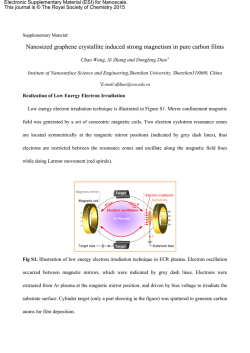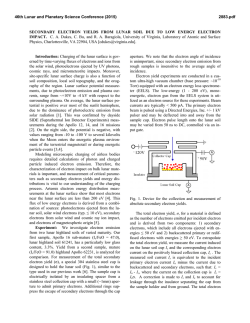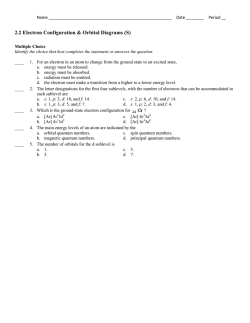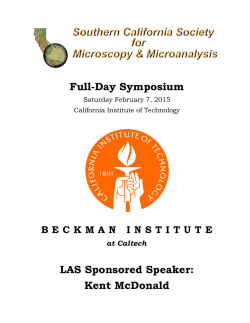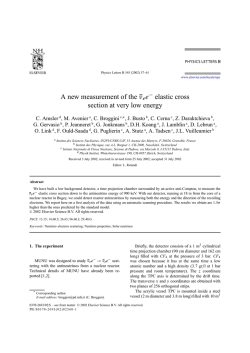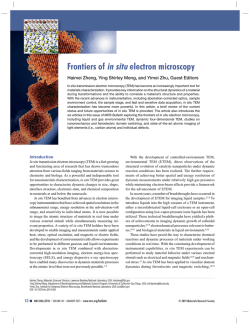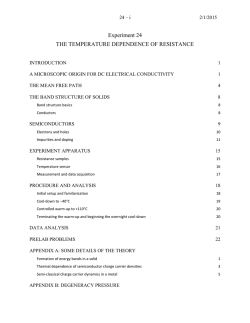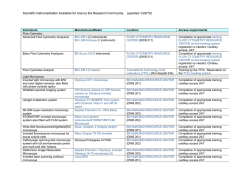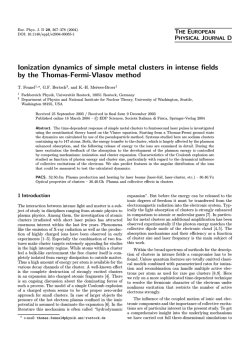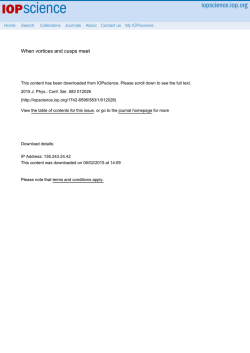
PDF (926 KB)
Home Search Collections Journals About Contact us My IOPscience Calculation of differential cross section for dielectronic recombination with one-electron uranium This content has been downloaded from IOPscience. Please scroll down to see the full text. 2015 J. Phys.: Conf. Ser. 583 012005 (http://iopscience.iop.org/1742-6596/583/1/012005) View the table of contents for this issue, or go to the journal homepage for more Download details: IP Address: 136.243.24.42 This content was downloaded on 06/02/2015 at 15:47 Please note that terms and conditions apply. 17th International Conference on the Physics of Highly Charged Ions Journal of Physics: Conference Series 583 (2015) 012005 IOP Publishing doi:10.1088/1742-6596/583/1/012005 Calculation of differential cross section for dielectronic recombination with one-electron uranium K N Lyashchenko and O Yu Andreev Department of Physics, St. Petersburg State University, Ulyanovskaya 3, Petergof, St. Petersburg, 198504, Russia E-mail: [email protected] Abstract. Calculation of the differential cross section for the dielectronic recombination with one-electron uranium within the framework of QED is presented. The contribution of the QED corrections and the interfernce of the photon multipoles is investigated. 1. Introduction The electron recombination, in particular, the dielectronic recombination with one-electron uranium is under intensive investigation during the last decade [1, 2, 3, 4, 5]. The present paper is devoted to calculation of the differential cross section of the dielectronic recombination with one-electron uranium within the framework of QED. We study a process, where an ion captures an electron and goes into a single excited state with emission of one photon e− + U 91+ (1s) → U 90+ (r) + γ → U 90+ (1s1s) + γ + γ 0 , (1) where r denotes one of the single excited states (1s2s), (1s2p). The first emitted photon (γ) can be registered in the experiment [5]. The interference between the first (γ) and the second emitted (γ 0 ) photons can be neglected [2]. If the energy of the initial state is close to the energy of a double excited state, the cross section shows resonances. The resonances are explained by the dielectronic recombination e− + U 91+ (1s) → U 90+ (d) → U 90+ (r) + γ → . . . , (2) where d is one of the double excited states (2s2s), (2s2p), (2p2p). 2. Electron recombination with a bare nucleus We consider first the electron recombination with a bare nucleus. In the zeroth order of the QED perturbation theory the amplitude of electron recombination is written as [6] Z U = e d3 r ψ b (r)γ ν A(k,λ)∗ (r)ψpµ (r) , ν (3) Content from this work may be used under the terms of the Creative Commons Attribution 3.0 licence. Any further distribution of this work must maintain attribution to the author(s) and the title of the work, journal citation and DOI. Published under licence by IOP Publishing Ltd 1 17th International Conference on the Physics of Highly Charged Ions Journal of Physics: Conference Series 583 (2015) 012005 IOP Publishing doi:10.1088/1742-6596/583/1/012005 where e is the electron charge; ψp,µ is a wave function of the incident electron with certain momentum p and polarization µ; ψb = ψnjlm is the wave function of the bound electron; 4(k,λ)∗ vector Aν describes the emitted photon with wave vector k = (ω, k) and polarization λ (k,λ) (A0 = 0, the transverse gauge is used); γ ν – Dirac gamma matrices. In the transverse gauge the photon wave function reads (the relativistic units are used) A (k,λ) r (r) = 2π ikr (λ) e e . ω (4) This function can be presented as [7] A (k,λ) r = 2π X l ∗ i gl (ωr)(e(λ) , Yjlm (k))Yjlm (r) , ω jlm (5) where gl (x) = 4πjl (x) and jl (x) is the spherical Bessel function. The pwave function ψp,µ (r) describes the incident electron with certain momentum (p), energy ( = 1 + p2 ) and polarization (µ). It is convenient to expand the wave function ψp,µ (r) in series over the wave functions of electron with certain energy, total angular momentum (j), its projection (m), and parity (l) [6] Z ψpµ (r) = d X apµ,εjlm ψεjlm (r) , (6) jlm apµ,εjlm = (2π)3/2 l iφjl + i e [Ωjlm (p)υµ (p)]δ( − ε) , √ p (7) where Ωjlm (p) is the spherical spinor and υµ (p) is the spinor with certain projection on the electron momentum (p), the phase φjl is the Coulomb phase shift. The wave function ψεjlm are normalized as Z + d3 r ψεjlm (r) ψε0 j 0 l0 m0 (r) = δ(ε − ε0 )δjj 0 δll0 δmm0 . (8) Accordingly, the electron recombination amplitude can be written as Uif = −e Z 3 d r X X ψn+b jb lb mb (r)~ α r jp lp mp jlm (2π)3/2 × √ p 2π (−i)lp glp (ωr)(e(λ)∗ Yjp lp mp (k))Yj∗p lp mp (r) ω il eiφjl [Ω+ jlm (p)υµ (p)]ψεjlm (r) , (9) where α ~ are Dirac alpha matrices. 3. Electron recombination with a one-electron ion The initial state (the bound (1s) electron and the incident electron) is described by Ψi = 1 √ det{ψp,µ , ψnb jb lb mb } . 2 (10) This function can be expanded over two-electron functions with certain total momentum (in the j-j coupling scheme) Ψi = X (0) (0) hΨJM j1 j2 l1 l2 | Ψi i ΨJM j1 j2 l1 l2 , JM j1 j2 l1 l2 2 (11) 17th International Conference on the Physics of Highly Charged Ions Journal of Physics: Conference Series 583 (2015) 012005 IOP Publishing doi:10.1088/1742-6596/583/1/012005 where (0) ΨJM j1 j2 l1 l2 X = N j1 j2 (m1 m2 ) det{ψn1 j1 l1 m1 , ψn2 j2 l2 m2 } . CJM (12) m1 m2 Here, n – the principle quantum number, j – total momentum of electron, l – parity, m – total j1 j2 (m1 m2 ) – Clebsch-Gordan coefficients. momentum projection, N – normalization constant, CJM The interaction with the quantized electromagnetic and electron-positron fields leads to various correction to the amplitude: interelectron interaction correction, electron self-energy and vacuum polarization corrections. For consideration of these corrections the line-profile approach (LPA) was employed [3, 4]. Within the LPA we introduce the set of two-electron configurations (g) which includes all the two-electron configurations composed by 1s, 2s, 2p, 3s, 3p, 3d electrons and the incident electron e. Within the LPA there is also introduced the matrix V which is defined by the one and two-photon exchange, electron self-energy and vacuum polarization matrix elements. Matrix V = V (0) + ∆V is considered as a block matrix V = V11 V12 V21 V22 " = (0) ∆V12 V11 + ∆V11 (0) ∆V21 V22 + ∆V22 # . (13) Matrix V11 is defined on set g, which contains configurations mixing with the reference state ng ∈ g. Matrix V (0) is a diagonal matrix: sum of Dirac energies. Matrix ∆V11 is not a diagonal matrix, but it contains a small parameter of the QED perturbation theory. Matrix V11 is a finite matrix and can be diagonalized numerically: diag V11 = B + V11 B , B+B = I . (14) Taking into account the interaction with the quantized fields leads to the substitution of Φng = X (0) Bkg ng Ψkg + kg ∈g X [∆V21 ]klg k∈g,l / g ∈g Blg ng (0) Eng − (0) Ek (0) Ψk + · · · . (15) (0) for Ψng functions, where ng = (JM j1 j2 l1 l2 ) is a reference state. Here, E (0) is the energy of the corresponding two-electron configuration. The amplitude of the electron recombination is given as a matrix element of the photon emission operator (Ξ(0) ) with the bra and ket-vectors given by the corresponding Φng functions: Uif = hΦf |Ξ(0) |Φi i , (0) Ξab = − Z d3 r ψa+ (r)(~ αA(k,λ)∗ (r))ψi (r) . (16) 4. Results We preset calculation of the diferential cross section for the electron recombination with oneelectron ion of uranium being in the ground state (1s) as a function of the incident electron energy (e ) and the angle of the emitted photon in the rest frame of the ion. The calculation is performed for the kinetic energy of the incident electron (e − me c2 ) within the interval [62.5, 64.2] keV. It supposed that the process of electron recombination is registered by registration of emitted photons with energy near the value ω ≈ e +1s−r, where r denotes a single excited configuration: (1s2s), (1s2p). The higher orders of the multipole expansion of the photon (0 < l0 < 10) were taken into account, what led to changes of 2 − 6% in the peaks area and up to 30% in the rest area of the differential cross section. The total cross section of the electron recombination was also calculated and found good agreement with the previous works [4, 5]. 3 17th International Conference on the Physics of Highly Charged Ions Journal of Physics: Conference Series 583 (2015) 012005 IOP Publishing doi:10.1088/1742-6596/583/1/012005 180 58 160 55 52 140 49 46 120 43 degree 40 37 100 34 31 80 28 25 60 22 19 16 40 13 10 20 7,0 4,0 63,85 63,90 63,95 64,00 64,05 64,10 64,15 energy of the incident electron (keV) Figure 1. The differential cross section for recombination of non-polarized electrons with non-polarized ions. The left graph corresponds to the full QED calculation and the right graph represents the calculation with disregard of the Breit interaction. Results for the differential cross section (in barn/str) for recombination of non-polarized electron with non-polarized ions are presented in Fig.(1). Results for the differential cross section (in barn/str) for recombination of polarized (µ = 1/2) electron with polarized (m = 1/2) ions are presented in Fig.(2). 180 180 58 160 64 160 61 55 58 52 140 140 49 55 52 46 43 120 49 120 46 43 37 100 34 31 80 28 degree degree 40 40 100 37 34 80 31 25 22 60 28 25 60 22 19 16 40 13 19 40 16 13 10 20 7,0 10 20 7,0 4,0 63,85 63,90 63,95 64,00 64,05 energy of the incident electron (keV) 64,10 64,15 4,0 63,85 63,90 63,95 64,00 64,05 64,10 64,15 energy of the incident electron (keV) Figure 2. The differential cross section for recombination of polarized electron with polarized ions. The left graph corresponds to the full QED calculation and the right graph represents the calculation with disregard of the Breit interaction. The presented calculation shows that the differential cross section of the electron and dielectronic recombination is very sensitive to the QED corrections and to the interference of the photon multipoles. Acknowledgments The authors acknowledge the support by RFBR grants 14-02-20188 and St. Petersburg State University for a research Grant No. 11.38.227.2014. References [1] [2] [3] [4] [5] [6] [7] Karasiov V V, Labzowsky L N, Nefiodov A V, and Shabaev V M 1992 Phys. Lett. A 161 453 Zakowicz S, Scheid W and Gr¨ un N 2004 J. Phys. B: At. Mol. Opt. Phys. 37 131 Andreev O Yu, Labzowsky L N, Plunien G and Solovyev D A 2008 Phys. Rep. 455 135 Andreev O Yu, Labzowsky L N and Prigorovsky A V 2009 Phys. Rev. A 80 042514 Bernhardt D et al. 2011 Phys. Rev. A 83 020701 Akhiezer A I 1965 Quantum Electrodynamics (New York: Wiley Interscience) Labzowsky L N 1996 Theory of atoms. Quantum electrodynamics of the electron shells and the processes of radiation (in Russian) (Moscow: Nauka) 4
© Copyright 2025
